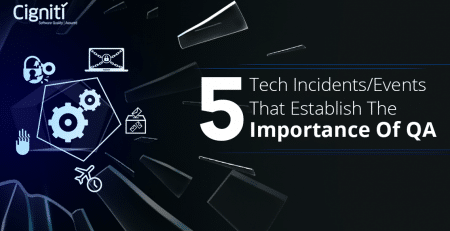How the quality culture is changing in tech world
|
Listen on the go!
|
Last month, Disney+ was launched and crashed on the same day due to several technical malfunctions that affected thousands of users. A Disney executive admitted that it was a ‘coding issue’ and they need to recode the application to meet the massive demand.
This incident is just one of the many examples of a sub-optimal approach toward software quality assurance. Disney wrongly anticipated the demand and thus, failed to prepare itself for the humongous user traffic.
The key goal of a quality assurance strategy or a quality transformation approach is to facilitate early defect detection while reducing the post-production defects to zero. Priyanka Halder, Sr. Manager of QA at Good Rx, recently spoke on our podcast about establishing a QA culture and building a winning QA team within digitally transforming enterprises. This blog is an excerpt from their interview on the QATalks podcast.
How do different organizations perceive quality engineering & quality assurance?
Having worked with organizations of various sizes and structures, including both CMMI level 5 organizations as well as startup companies, Priyanka has learnt several factors that affect an enterprise’s perception and approach toward quality assurance and quality engineering. The size of the company and the type of their offered product/service play a central role in determining their outlook for QA.
The size of an organization and their QA department are not directly proportional to each other. Priyanka notes that it all depends on what kind of product they offer, what bug tolerance level they have, and wherein their STLC lifecycle QA needs to happen. A big company does not necessarily have a large QA department and vice-versa. In addition to the bug tolerance level and the QA budget, the buy-in of the top level is also an important determinant for an organization’s perception for QA and QE.
What are the key factors that drive the QA transformational journey of the global enterprises?
Commitment, communication, and change management are the three most important factors that drive a successful QA transformational journey.
Without the management commitment, it is extremely unlikely to achieve the desired results from the transformation efforts. Secondly, it is essential to clearly communicate to the team why we are doing it, what are we going to achieve from it, and more importantly, celebrating the intermediate milestones while keeping the end objective in mind. Finally, the enterprises need to involve the entire team to avoid any conflict, control the fear toward the impending change, and induce more openness within the team for the transformation.
What are the tangible benefits that organizations gain by partnering with an independent QA service provider?
Some of the key tangible benefits that organizations get by leveraging QA services are:
- Reduced post-production defect density
- Early defect detection by shifting left
- Improved overall test coverage
- Overall cost reduction through innovation
What are the key things an enterprise should consider while building a QA team from scratch?
Priyanka follows a 3-step strategy for building a winning team that is capable of driving a successful QA transformation:
Step 1: Learning the bottlenecks
The first step is to identify and learn the bottlenecks that prevented an organization from having a successful QA team. This also involves the identification of all the available resources and their capabilities for determining the strategic gaps that need to be filled.
Step 2: Run the POCs
By having such a holistic picture in mind, it becomes easier to produce 3-4 possible approaches and run their Proof of Concept (POC) for 30-60 days. Doing so will help determine the best course of action that will generate the greatest outcomes.
Step 3: Scale on the success of the POC
Once the approach is finalized based on the success of the POC, the next step involves scaling up. While the POC is run for a period of only 30-60 days, it gives a fair idea of how the organization will synchronize with the chosen approach. Thus, it becomes feasible to scale the approach for a longer period.
What are the benefits that one can achieve from crowdtesting?
The benefits of crowdtesting are:
- Cost effectiveness: Crowdtesting is significantly cheaper from having so many people on the team
- Huge coverage: Having, for example, about 40 people look at an application on different devices, browsers, and operating systems help achieve huge testing coverage.
- Scalability: While looking at scaling the QA efforts, crowdtesting is the fastest and the cheapest way.
How IP and innovation help enterprises in their QA transformation journey?
Many times what we find is that the organizations are facing problems that the existing tools are not able to solve. That is why we started developing our own tools, utilities, and sometimes methodologies over a period of time. What we found out is that while the problems are a little bit unique for each client but there is a pattern in some of these problems that we are solving. To address that, we sort of productized some of the tools, utilities, and methodologies that we had built & packaged all of these under one name, that is, BlueSwan. It is basically the testing IP that Cigniti has packaged to help organizations achieve their digital transformation journey & also accelerate their DevOps journey. As part of BlueSwan, we have different components that can help in different aspects of testing – it could be test automation, digital testing, establishing quality management system, and putting together quality management dashboard at the enterprise level.”
How quality engineering can help teams bring innovative approach toward their seamless functioning?
“Working in a cohesive manner, as a whole engineering team, achieves quality engineering”, says Priyanka.
She further explains, “Seamless functioning comes when everyone does their part – the developers are doing their happy path testing, the testers are doing their HKs & cross browsers, and the product is doing their UAT. Then we have a laid-out process like how in an AGILE environment, we are achieving it faster with help of some tools like Jira or testrail where everybody knows what next is going to happen. Everybody in that particular AGILE team like developers, testers, or product owner knows exactly what is going to happen next. Only that way we can achieve seamless functioning.”
To Conclude
To sum up, Priyanka emphasizes on the growth of QA over the years. She says, “I think in quality space we have achieved significant progress in a couple of years. There are so many new terms like shift–left, shift–right, test more, quality engineering. But at the end of the day, it is a whole company’s approach.”
New age organizations and enterprises today are working towards achieving Digital Transformation and translating the transformation into commercial success. This specifically needs the right digital skills and proven expertise to assure digital effectiveness across the enterprise. Cigniti’s Quality Engineering services ensure that testing shifts left and begins way ahead in the overall SDLC, ensuring maximum test coverage and quality.
We achieve this with:
- A strategic and result-oriented approach that automates and integrates the entire landscape for seamless functioning.
- A comprehensive Digital Assurance & Testing strategy that provides scalable, reusable assets and enablers for improving the overall efficiency of Quality Assurance and Testing processes.
Connect with us.





Leave a Reply